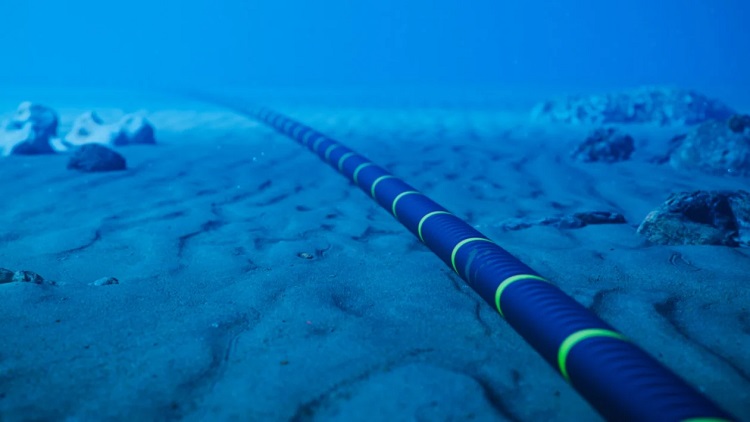
Submarine cables are made up of underwater fiber-optic cables that are bundled glass strands that are laid on the ocean floor and used to carry data between two or more landing places.
Fiber optics are used in contemporary undersea cables. Lasers are fired at incredibly high speeds from one end of the wire down fine glass fibers to receptors at the other end. For safety, layers of plastic (and occasionally steel wire) are wrapped around these glass fibers.
Deep-sea seismic activity and ocean waves may be detected using a 10,000 km long fiber-optic cable owned by Google that is at the bottom of the Pacific Ocean.
Researchers at Google and Zhongwen Zhan of the California Institute of Technology in Pasadena, California, utilized traffic data from an optical fiber owned by the internet giant to quantify variations in pressure and strain in the cable. They were able to identify earthquakes and storm-generated swells in the ocean using this data.
The scientists tracked 30 ocean storm swell occurrences over a nine-month period and 20 earthquakes of a magnitude of 5 or above, which are powerful enough to cause damage to structures, including the magnitude 7.4 earthquake that occurred in June 2020 close to Oaxaca, Mexico. The team had hoped to record a tsunami, but none was seen while they were watching.
Underwater seismic stations are very uncommon since it is challenging and expensive to deploy and maintain geophysical sensors on the bottom.
Efforts to employ fiber-optic cables as seismic sensors have been made in the past, but they required either the use of specialized laser detecting equipment at both ends of the line or the use of specialized fibers within the cables. It would be challenging to dedicate one of these deep-sea cables' limited supply of such fibers to measuring earthquakes.
Since no new infrastructure is required, Zhan claims that his team's strategy of exploiting an existing traffic fiber is more flexible and scalable. This is interesting because there would be huge rise in the volume and coverage of seismic data even if only a small portion of the million kilometers of submarine fiber-optic networks could be used as sensors.
The most important benefits of using underwater fiber-optic cable by Google are given below:
Can we develop a less expensive approach to geophysical cover the ocean?
These cables may one day provide early tsunami warnings to residents on the beach in addition to their primary function of transmitting data around the globe. They could also enable seismologists and geophysicists to examine undersea earthquakes in more detail. Since almost all of the sensors used to detect earthquakes at the moment are on land, these cables might significantly increase scientists' capacity to monitor seismic activity. The cutting-edge method doesn't even call for adding any new hardware to the seafloor's current network of more than a million kilometers of fiber optic cables.
The new strategy makes use of the functions that cables are currently built to do. Light waves are pointed in a certain direction when a transmitter at one end of the cable transmits a light signal carrying data. The wire may shake, bend, or twist during an earthquake, which will alter the direction of the light waves. Google detects distortions at the other end of the wire and fixes them. In order for seismologists like Zhan to analyze the earthquakes that created the distortions, it now wants to share its data—changes to what is known as the "state of polarization" of light—with them.
Approximately 20 moderates to large earthquakes were recorded between December 2019 and September 2020 by Zhan's study team using Google's 10,500-kilometer-long Curie cable, which connects Los Angeles, California, and Valparaiso, Chile. Also, the cable was able to gather up storm-related ocean surges. This implies that the method may be used to detect tsunamis, which earthquakes can cause.
It may be possible to save lives if tsunamis are detected when they are still distant from the coast
Fiber optic cables can convey warnings to shore considerably quicker — maybe in a matter of milliseconds — than the few current sensors that are particularly intended to search for tsunamis, in addition to having a superior view of the ocean.
Similar studies that revealed the possibility for seabed cables to detect earthquakes and tsunamis were reported in 2018, although that technique had several problems. To shoot lasers down cables, specialist equipment has to be inserted inside the cables. This new strategy, in contrast, costs less money because it doesn't call for any new infrastructure. There were also worries that adding equipment to the cables may invite security failures and provide malicious parties access to data flowing over the network. That is not a problem with the new method, according to Zhan, because when examining the polarization of light, scientists cannot discern information about the transmitted content.
According to recent study, the web of underwater cables that transfer data across the globe may someday be used to monitor earthquakes and tsunamis. One of Google's fiber-optic cables successfully detected irregularities in light pulses transmitted through the line during a test run last year, enabling it to detect nearby earthquakes. It represents a fresh approach to a concept on which experts have been working for a while.